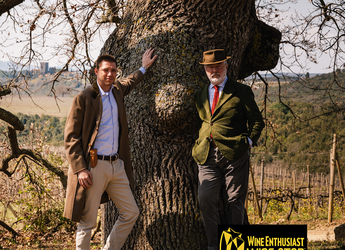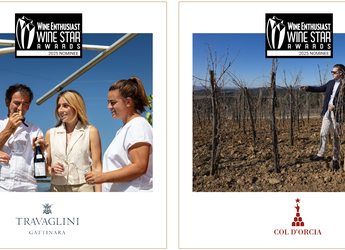
Batasiolo Wines The Ultimate Cru Expressions of Barolo

For five generations, the Dogliani family have been fixtures in the Langhe wine region. In 1963, when a young Fiorenzo Dogliani made the intrepid move to pitch his family’s homemade wines (handwritten labels and all) to restaurateurs in Milan, he had no way of knowing it was the start of a whole new era.
The Doglianis Langhe wine was a big hit — demand, along with their reputation, grew at a rapid pace. The family would go on to purchase the historic Kiola estate and Batasiolo Hills in 1978, adding two more beni (“estates”) to their existing seven estates. It was Fiorenzo who thought to call their new, larger venture “Beni di Batasiolo” after the central vineyard where the winery and cellar are located in the village of La Morra.
Today, the family work on 130+ hectares / 320+ acres of prime Barolo land, including five prestigious “cru” vineyards: Cerequio, Bussia Bofani, Brunate, Briccolina, and Boscareto. These prized spots produce some of the most age-worthy and elegant Barolos of all (and, in 2010, would each be included in the Barolo consorzio’s list of designated Menzioni Geografiche Aggiuntives, or MGAs, further cementing their sought-after status).
Fiorenzo sums up the Batasiolo approach to Barolo wine production: “A good wine reveals the soul of its vineyard to the world, evoking its traditions and encapsulating the unique notes of the season that ripened its grapes. Every vintage conjures a different emotion, making it truly unique. Our ambition is to reflect this difference in our wines.”
Beni di Batasiolo Highlights
The Dogliani family have lived in Italy’s Langhe district for five generations, and their Beni di Batasiolo spans nine estates across Piedmont.
Among Batasiolo’s vineyard holdings are five top-sited crus, each of which are also designated Menzioni Geografiche Aggiuntive (MGA): Cerequio, Bussia, Brunate, Briccolina, and Boscareto.
Batasiolo’s wines have earned a place on Wine Spectator’s Top 100 list six times to date.

-
Founded
1978 -
Location
Piedmont, Italy -
Follow On
Piedmont’s Epicurean Allure
It is hard to deny the beauty of Barolo country. Home to steeply rolling hills (often draped in diaphanous morning fog or illuminated by oblique rays of sunlight), this famous Piedmont district is particularly alluring for epicureans. It isn’t just nebbiolo wines that thrive here. Other delicacies, like Alba’s ultra-rare white truffles, hazelnuts, and Castelmagno cheese are an important part of local life. Piedmont’s cultural value is so great, its entire vineyard landscape — including the village of La Morra, home to Beni di Batasiolo — was granted UNESCO World Heritage Site status in 2014.

Terroir
Piedmont’s climate is impacted by both the cooling influence of the Alps and balmy warmth from the Mediterranean — the clashing of these forces creates a huge diurnal swing marked by cool nights, foggy mornings, and warm, sunny days. The Barolo terroir consists of two main, distinct soils: clay-dominant Tortonian in the west and sandy, limestone-rich Serravallian/Helvetian in the east.
Tortonian soils yield wines that are lighter and more accessible in their youth, with a highly perfumed, velvety-soft character; they provide a base for three of Batasiolo’s crus. Bussia Bofani enjoys a southwest exposure on the hilly slope of Munie, with mainly clay soils comprising calcified marl. Cerequio — one of Barolo’s most historic vineyards — has a south/southeast exposure and sits on compact blue marl, woven together at serious depths with sandy, mineral-rich veins. It shares a similar soil composition with southern-facing Brunate, to which it is adjacent.
Batasiolo’s other two crus sit atop Serravallian/Helvetian soils, which deliver powerful, austere wines with incredible structure. The Boscareto vineyard (the highest of the crus at 421 meters / 1,381 feet) is on a southwest-facing slope of fossilized marl with a high concentration of limestone and clay. And the diminutive Briccolina vineyard (also southwest-facing and clocking in at just 1.6 hectares / 4 acres) sits on fossilized marl rich in limestone and calcium carbonate.

Knowledge Rooted in Experience
Fiorenzo Dogliani is Batasiolo’s managing director — a second-generation winemaker who got his start in 1962 in the wine business with his four brothers and three sisters to create Fratelli Dogliani (“Dogliani Brothers”). Over his decades-long career, Fiorenzo has received numerous accolades for his work, including his recent inclusion among the “Grandi Cru d’Italia,” a group of incredibly prestigious Italian wineries that represent the highest cultural expressions of the country’s top regions. He is joined by the estate’s oenologists, Oresete Dogliani and Paolo Pronzato. Two crucial values guide them: knowledge built on the experiences gained by their forefathers and an instinct-led personal touch.









